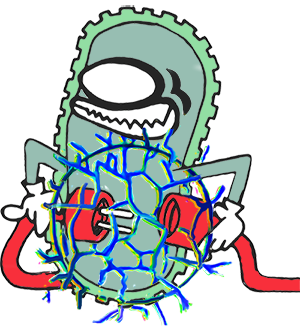Team:TU Delft-Leiden/Project/Life science/EET/characterisation
From 2014.igem.org
Extracellular Electron Transport Module - Characterisation
We have succeeded to BioBrick mtrCAB under control of an adjusted T7lac promoter, resulting in BBa_K1316012. However, to complete the implementation of the extracellular electron pathway we constructed BBa_K1316011 , encoding the ccm genes under control of the pFAB640 promoter. This combination of promoters and coding sequences was found to generate the largest maximal current [1].
To characterize BBa_K1316012 and BBa_K1316011 we made use of SDS-page and UV-vis to see if the proteins are expressed. In addition, we made use of a potentiostat to do advanced current measurements. [ADD LINKS] We were able to visualize expression of ccm genes, and showed that our induction of our BioBricks results in a current flow.
Characterization of BBa_K1316011
The CCM cluster is a cluster consisting of genes encoding for several (parts of) proteins. The cytochrome C maturation (Ccm) system consists of heme delivery proteins that help the conduit proteins, such as the proteins in the MtrCAB operon, to mature properly by translocate heme in the periplasm and catalyzes the formation of thioether bonds that link heme to two cysteine residues. The axial ligands are then coordinated to the heme iron and the holocytochrom C is folded. In these strains, no conduit proteins are inserted, but the heme delivery proteins should be more expressed. When there is an increased expression of heme delivery proteins, that can already be seen by the redness of the pellets (because of the heme) after the membrane purification.
Membrane purification and UV-VIS
To look into the expression of the cytochrome c maturation (Ccm) proteins, an UV-VIS has been done. E. coli (C43) cultures were transformed with BBa_K1316011 and then cultivated aerobically. E. coli (C43) CcmA-H+NdeI from the Ajo-Franklin lab and E. coli (C43) without plasmid were used as a positive and negative control, respectively. BBa_K1316011 expected to have more expression of the Ccm proteins than the normal E. coli (C43) strain and more equal expressions compared with E. coli (C43) CcmA-H+NdeI because of the inserted Ccm operon. When there is an increased expression of heme delivery proteins, that can already be seen by the redness of the pellets (because of the heme) after induction with IPTG.

Before membrane protein purification, BBa_K1316011 and the controls where induced with IPTG. Analysis of the pellets shown that there was a difference in color in BBa_K1316011 and E. coli (C43) CcmA-H+NdeI compared with E. coli (C43). The BBa_K1316011 and E. coli (C43) CcmA-H+NdeI had a red color, which could be indicating the increased production of cytochrome c proteins because of the heme delivery proteins. Membrane protein purifications where done by low-speed and high-speed centrifugation.

According to Reedy, C. J. & Gibney, B. R. et al (2004), there should be a peak around 550nm for cytochrome c proteins. Using the UV-VIS results, there is a peak for all membrane fractions around 550nm, so it is possible to confirm the expression of cytochrome c proteins in all the samples. There is a difference between E. coli (C43) without plasmid and BBa_K1316011, as shown in figure 1. These observations confirm that BBa_K1316011 offer enhanced cytochrome c expression compared to the E. coli (C43) strain without plasmids.
SDS-PAGE
A SDS-PAGE has been done with the membrane fractions for E. coli (C43), E. coli (C43) CcmA-H+NdeI and BBa_K1316011. As mentioned before, no conduit proteins, such as the proteins in the MtrCAB operon, are included in this strains. When the MtrCAB operon was included, the membrane fractions of BBa_K1316011 and the positive control should contain MtrA, a 32-kD periplasmic decaheme cytochrome c, MtrC is a 69-kD cell-surface-exposed lipid-anchored decaheme cytochrome c and MtrB is a 72-kD predicted twenty-eight strand β-barrel outer membrane protein.

There’re no significant differences between BBa_K1316011 and both positive and negative controls observed using SDS-PAGE. This is what was expected because the MtrCAB operon is not included yet in these cells.
References
1. C.P. Goldbeck et al., Tuning promoter strengths for improved synthesis and function of electron conduits in E. coli ACS Synth. Biol. 2 (3), pp 150–159 (2013)
 "
"






